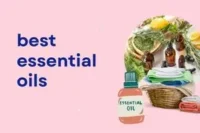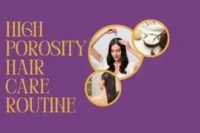How Protein for Hair Transforms Your Locks- Repair, Strengthen, Shine
Published: 13 Feb 2025
Are you tired of brittle, weak, or dull hair? Good news, there’s a simple fix that often gets overlooked: protein for hair. Protein is a vital part of hair structure and health. It strengthens your strands, repairs damage, and adds shine. No matter your hair type, fine, thick, curly, or chemically treated, protein can make a noticeable difference. In this guide, you’ll learn how protein works, how to use it, and how to avoid overuse.
1. What is Protein for Hair?
Protein is the main component of hair. Your hair is made mostly of keratin, a type of protein. This protein forms the hair shaft and gives it strength, flexibility, and structure. When your hair lacks protein, it becomes weak and prone to breakage—making protein hair masks essential for restoring strength and resilience.
Adding protein back into your routine can rebuild and protect your strands.
2. Understanding Hair: Structure, Health, and the Power of Protein
Hair is made up of keratin, a protein that gives it strength, elasticity, and resilience. Understanding the structure—from cuticle to cortex—helps you care for it more effectively.
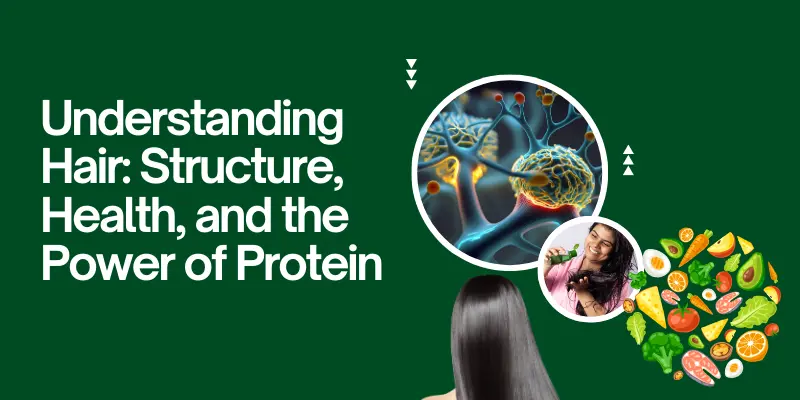
Protein treatments can repair damage, restore moisture balance, and boost overall hair health. When protein and care align, your hair thrives from root to tip.
Hair Structure
Your hair has three layers:
- Cuticle – The outer layer that protects your hair.
- Cortex – The middle layer, rich in keratin, moisture, and pigment.
- Medulla – The innermost part, often missing in fine hair.
Why Hair Health Matters
Healthy hair resists damage, stays shiny, and holds styles better. Protein helps maintain this strength and support hair’s elasticity and resilience.
3. What Types of Protein Does Hair Need?
Different types of protein serve different needs. Here are the most effective ones:

Different types of protein serve different needs. Here are the most effective ones:
- Hydrolyzed Proteins
These are small enough to penetrate hair easily. Examples include: - Plant-Based Proteins
Suitable for plant-based routines: - Animal-Derived Proteins
Powerful for repairing damage:- Keratin from wool or feathers
- Silk protein
Choose your protein based on the type of hair and condition.
4. How to Know If Hair Needs Moisture or Protein
If your hair feels dry, brittle, and breaks easily, it likely needs moisture; if it’s limp, stretchy, or lacks elasticity, it may need protein. Understanding these signs helps restore balance and improve overall hair health.
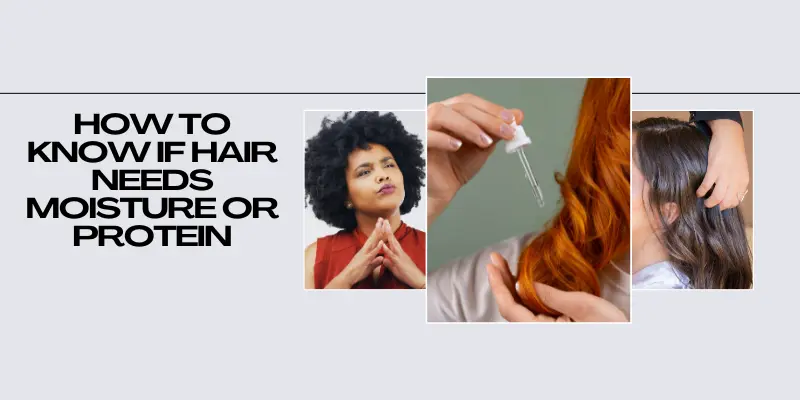
Your Hair May Need Protein If:
- It breaks easily or has split ends
- It stretches and doesn’t return to shape
- It feels soft but breaks when combed
- It’s damaged from coloring or chemical treatments
Your Hair May Need Moisture If:
- It feels dry, rough, or brittle
- It tangles quickly
- It looks dull and lacks softness
Tip: Hair needs both protein and moisture, but in the right balance.
5. How to Add Moisture to Hair
Moisture keeps hair soft and flexible. Try these:
- Use deep conditioners weekly
- Apply leave-in conditioners
- Use natural oils like coconut, argan, or olive oil
- Avoid overwashing, which strips natural oils
6. How to Add Protein to Hair
To strengthen your hair, try:
- Protein-rich shampoos and conditioners
- Deep conditioning protein masks weekly or bi-weekly
- Leave-in protein treatments for light maintenance
- DIY protein masks, like egg or yogurt with honey
Start slow and adjust based on how your hair feels.
7. How Often Should You Use a Protein Treatment?
Frequency depends on hair type and damage:
- Fine hair: Every 2–3 weeks
- Thick hair: Once a week
- Chemically treated hair: Weekly until repaired, then less often
Always follow up with moisture to maintain balance.
8. How to Know If Hair Has a Protein Overload
Protein overload happens when there’s too much protein and not enough moisture.
Signs Include:
- Hair feels stiff or straw-like
- Increased breakage
- Less flexibility
- Dry and rough texture
To Fix It:
Try hydrating masks until balance returns
Pause protein treatments
Use moisturizing shampoos and conditioners
9. Protein Treatments: Types and Application
Protein treatments range from light leave-ins to intense reconstructors, each targeting different levels of hair damage.
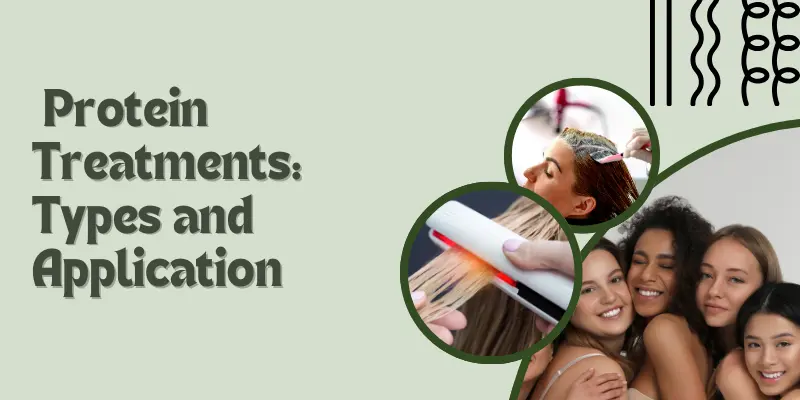
Apply them based on your hair’s needs—typically every 4–6 weeks—to strengthen and restore weak, over-processed strands.
Deep Conditioning Protein Masks
Best for damaged hair. Use once a week.
Leave-In Protein Treatments
Good for daily support. Lightweight and easy to use.
Protein Shampoos and Conditioners
Help maintain protein levels with every wash.
DIY Protein Masks
Simple home options include egg masks or a yogurt hair mask blended with honey.
10. Balancing Protein and Moisture
Too much protein makes hair hard. Too much moisture makes hair weak.
Tips for Balance:
- Alternate between protein and moisturizing products
- Watch how your hair responds after each treatment
- Stick to a routine that keeps your hair soft, strong, and elastic
11. Choosing the Right Protein Products for Your Hair Type
Choose protein products that match your hair type—light proteins for fine or low-porosity hair, and richer formulas for thick, damaged, or high-porosity strands.
For Fine Hair
Use light proteins like hydrolyzed wheat or silk.
For Thick Hair
Choose richer formulas with keratin or collagen.
For Curly Hair
Look for balanced formulas with both protein and moisture.
For Chemically Treated Hair
Go for intensive protein masks that rebuild damaged strands.
12. Common Myths About Protein in Hair Care
Let’s clear the air, this guide is free of myths. Here’s what’s true:
- Protein helps all hair types, not just damaged ones.
- Different proteins work differently based on size and type.
- Too much protein is harmful; balance is always key.
Conclusion
Protein for hair is essential for strong, shiny, and healthy strands. Whether you’re dealing with damage, dullness, or simply want stronger hair, adding protein to your routine can be transformative. Focus on balancing protein and moisture, choose products suited to your hair type, and pay attention to what your hair needs. Your journey to better hair health starts with understanding this powerful ingredient.
FAQs About Protein in Hair Care
Protein is an essential building block for hair health because it strengthens the hair shaft from within. It helps repair damage caused by heat styling, chemical treatments, and environmental stress. By reinforcing the structure of each strand, protein improves elasticity and reduces the likelihood of breakage. It also adds a healthy shine, making hair look fuller and smoother. Without adequate protein, hair can become weak, limp, and prone to damage.
If your hair stretches too much before snapping or breaks easily with minimal tension, it may be lacking protein. Other signs include a noticeable loss of curl pattern, dullness, and a straw-like texture. Chemically treated hair, especially after bleaching or coloring, often shows these symptoms. Hair that feels overly soft and mushy when wet can also indicate protein deficiency. Observing these signs early can help you prevent more serious damage.
Yes! Protein is beneficial for all hair types, even if your hair isn’t damaged. For healthy hair, protein treatments act as a preventive measure, strengthening the strands and protecting them from future damage. They can help maintain hair’s elasticity, resilience, and shine over time. The key is moderation — use protein as part of a balanced routine with adequate moisture. This will keep hair strong without causing stiffness.
Different proteins work in slightly different ways, so the best choice depends on your hair’s needs. Hydrolyzed keratin is excellent for repairing structural damage, while silk protein enhances smoothness and shine. Collagen can help improve elasticity and resilience, making hair more flexible. Wheat protein is lightweight and ideal for fine hair that needs strength without added heaviness. Mixing different proteins in your routine can offer well-rounded benefits.
The frequency depends on your hair type, condition, and how it responds to protein. Fine or slightly damaged hair usually benefits from treatments every 2–3 weeks. Thick, coarse, or severely damaged hair can tolerate weekly or bi-weekly treatments. Overuse can cause stiffness, so monitor your hair’s texture after each session. Always follow up with a moisturizing treatment to maintain balance.
Yes, if overused, protein can make hair stiff, brittle, and more prone to breakage. This happens because excess protein builds up on the hair shaft, reducing flexibility. To prevent this, always pair protein treatments with moisture-rich conditioners or masks. Listen to your hair — if it feels dry or rough after protein use, it might need a moisture-focused break. Balanced care is essential for long-term hair health.
Protein overload often results in hair that feels stiff, coarse, and unusually dry to the touch. Strands may snap easily when brushed or manipulated, even if they look healthy. The hair can lose its natural movement and elasticity, feeling rigid instead. In severe cases, breakage can occur in multiple areas. Restoring balance requires deep moisturizing treatments and reducing protein use until normal softness returns.
Maintaining this balance involves alternating protein and moisture treatments according to your hair’s needs. For example, you might use a protein mask one week and a hydrating mask the next. Pay attention to how your hair responds — too much moisture can make it limp, while too much protein can make it stiff. Protective styles, gentle handling, and regular trims can also help preserve this balance. Healthy hair thrives when both elements are in harmony.
DIY treatments can be effective for mild strengthening or maintenance, especially those using ingredients like eggs, yogurt, or rice water. However, these natural proteins are often larger molecules that may not penetrate the hair shaft deeply. Commercial treatments usually contain hydrolyzed proteins, which are broken down for better absorption and lasting results. For light upkeep, DIY works fine, but for deep repair, professional formulas are more reliable.
Yes, protein is especially beneficial for color-treated hair, which often experiences structural weakening during the dyeing process. It helps rebuild and reinforce the damaged cuticle layers, improving strength and resilience. Protein treatments can also enhance color retention by reducing porosity, which minimizes fading. When used alongside moisturizing products, they help keep color-treated hair soft, shiny, and healthy. Consistent care will extend both your color and hair health.

- Be Respectful
- Stay Relevant
- Stay Positive
- True Feedback
- Encourage Discussion
- Avoid Spamming
- No Fake News
- Don't Copy-Paste
- No Personal Attacks



- Be Respectful
- Stay Relevant
- Stay Positive
- True Feedback
- Encourage Discussion
- Avoid Spamming
- No Fake News
- Don't Copy-Paste
- No Personal Attacks



